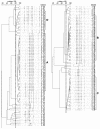Biogeography of the purple nonsulfur bacterium Rhodopseudomonas palustris
- PMID: 12957900
- PMCID: PMC194913
- DOI: 10.1128/AEM.69.9.5186-5191.2003
Biogeography of the purple nonsulfur bacterium Rhodopseudomonas palustris
Abstract
The biogeography of the purple nonsulfur bacterium Rhodopseudomonas palustris on a local scale was investigated. Thirty clones of phototrophic bacteria were isolated from each of five unevenly spaced sampling locations in freshwater marsh sediments along a linear 10-m transect, and a total of 150 clones were characterized by BOX-PCR genomic DNA fingerprinting. Cluster analysis of 150 genomic fingerprints yielded 26 distinct genotypes, and 106 clones constituted four major genotypes that were repeatedly isolated. Representatives of these four major genotypes were tentatively identified as R. palustris based on phylogentic analyses of 16S rRNA gene sequences. The differences in the genomic fingerprint patterns among the four major genotypes were accompanied by differences in phenotypic characteristics. These phenotypic differences included differences in the kinetics of carbon source use, suggesting that there may be functional differences with possible ecological significance among these clonal linages. Morisita-Horn similarity coefficients (C(MH)), which were used to compare the numbers of common genotypes found at pairs of sampling locations, showed that there was substantial similarity between locations that were 1 cm apart (C(MH), >/=0.95) but there was almost no similarity between locations that were >/=9 m apart (C(MH), </=0.25). These calculations showed there was a gradual decrease in similarity among the five locations as a function of distance and that clones of R. palustris were lognormally distributed along the linear 10-m transect. These data indicate that natural populations of R. palustris are assemblages of genetically distinct ecotypes and that the distribution of each ecotype is patchy.
Figures



Similar articles
-
Spatial distribution of Rhodopseudomonas palustris ecotypes on a local scale.Appl Environ Microbiol. 2003 Sep;69(9):5192-7. doi: 10.1128/AEM.69.9.5192-5197.2003. Appl Environ Microbiol. 2003. PMID: 12957901 Free PMC article.
-
Genotypic and phenotypic diversity within species of purple nonsulfur bacteria isolated from aquatic sediments.Appl Environ Microbiol. 2002 Jul;68(7):3467-77. doi: 10.1128/AEM.68.7.3467-3477.2002. Appl Environ Microbiol. 2002. PMID: 12089030 Free PMC article.
-
Analysis of diversity among 3-chlorobenzoate-degrading strains of Rhodopseudomonas palustris.Microb Ecol. 2004 Jan;47(1):68-79. doi: 10.1007/s00248-003-1028-5. Microb Ecol. 2004. PMID: 15259271
-
Descriptions of Rhodopseudomonas parapalustris sp. nov., Rhodopseudomonas harwoodiae sp. nov. and Rhodopseudomonas pseudopalustris sp. nov., and emended description of Rhodopseudomonas palustris.Int J Syst Evol Microbiol. 2012 Aug;62(Pt 8):1790-1798. doi: 10.1099/ijs.0.026815-0. Epub 2011 Oct 10. Int J Syst Evol Microbiol. 2012. PMID: 21986724
-
Characteristics and Application of Rhodopseudomonas palustris as a Microbial Cell Factory.Front Bioeng Biotechnol. 2022 May 12;10:897003. doi: 10.3389/fbioe.2022.897003. eCollection 2022. Front Bioeng Biotechnol. 2022. PMID: 35646843 Free PMC article. Review.
Cited by
-
Whole-genome sequencing and comparative analysis of two plant-associated strains of Rhodopseudomonas palustris (PS3 and YSC3).Sci Rep. 2018 Aug 24;8(1):12769. doi: 10.1038/s41598-018-31128-8. Sci Rep. 2018. PMID: 30143697 Free PMC article.
-
Genetic population structure of the soil bacterium Myxococcus xanthus at the centimeter scale.Appl Environ Microbiol. 2006 May;72(5):3615-25. doi: 10.1128/AEM.72.5.3615-3625.2006. Appl Environ Microbiol. 2006. PMID: 16672510 Free PMC article.
-
In situ phylogenetic structure and diversity of wild Bradyrhizobium communities.Appl Environ Microbiol. 2009 Jul;75(14):4727-35. doi: 10.1128/AEM.00667-09. Epub 2009 May 29. Appl Environ Microbiol. 2009. PMID: 19482951 Free PMC article.
-
Chimaeric load among sympatric social bacteria increases with genotype richness.Proc Biol Sci. 2014 Jul 22;281(1787):20140285. doi: 10.1098/rspb.2014.0285. Proc Biol Sci. 2014. PMID: 24870038 Free PMC article.
-
Bacterial succession in a glacier foreland of the High Arctic.ISME J. 2009 Nov;3(11):1258-68. doi: 10.1038/ismej.2009.71. Epub 2009 Jul 9. ISME J. 2009. PMID: 19587774 Free PMC article.
References
-
- Altschul, S. F., W. Gish, W. Miller, E. W. Myers, and D. J. Lipman. 1990. Basic local alignment search tool. J. Mol. Biol. 215:403-410. - PubMed
-
- Arber, W. 2000. Genetic variation: molecular mechanisms and impact on microbial evolution. FEMS Microbiol. Rev. 24:1-7. - PubMed
-
- Begon, M., J. L. Harper, and C. R. Townsend. 1996. Ecology: individuals, populations and communities, 3rd ed. Blackwell Science Ltd., Oxford, United Kingdom.
Publication types
MeSH terms
Substances
LinkOut - more resources
Full Text Sources
Other Literature Sources
Molecular Biology Databases

